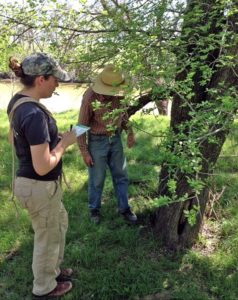Documenting Native Vegetation in Mills County, TX
FOR IMMEDIATE RELEASE
Thursday, October 27, 2016
STEPHENVILLE, Texas—As part of a scientific field investigation along the Colorado River, a team of faculty and students from Tarleton State University have expanded the number of recorded plant species and varieties in nearby Mills County by 49.
Dr. Allan Nelson, department head and professor of Tarleton’s Department of Biological Sciences, and Dr. Randy Rosier, a professor in the university’s Department of Animal Sciences and Veterinary Technology, have worked with undergraduate students Kimberly Hogan from Dublin, Texas, and Keagan Lowey from Jacksboro, Texas, as well as graduate student, Turner Cotton from Missouri, to document new Mills County records and major range extensions for plants along the Texas river.
Most recently, the research team documented the native vegetation in bottomlands along the Colorado River. Their research took place at the 790-acre Timberlake Ranch near Goldthwaite, which Marilynn and Dr. Lamar Johanson donated to Tarleton.
In addition to recording and collecting plants in the bottomlands, the team documented the diversity and richness within the woody forest and the consumption of plants by mammals. Preliminary results of this investigation along the Colorado River expanded the number of recorded plant species and varieties in Mills County by 49.
The team is compiling a scientific paper that has been accepted for publication by the Texas Journal of Science. The group presented its findings at three conferences, including the 2014 Texas Plant Conservation Conference and 2015 Texas Chapter of the Wildlife Society.
The team also is working to describe plant community structure for the first time along the Colorado River and comparing these results to other rivers in the state. It appears that the cedar elm-green ash bottomland has a higher percentage of green ash compared to other Texas bottomlands. Because ash species worldwide are becoming rare due to insect pests, this site is important for plant conservation in Texas.
Since the generous donation by the Johansons, the university has established a biological field station at the site—Timberlake Biological Field Station—directed by Tarleton Associate Professor Dr. Chris Higgins. In addition to research, the station is used for field trips and classes of college and public school students.
Higgins has worked to make the ranch a certified field site for the Texas Aquatic Science program and has written grants to the National Science Foundation, which would provide funds for more student research and educational programs.
Tarleton, a member of The Texas A&M University System, provides a student-focused, value-driven educational experience marked by academic innovation and exemplary service, and dedicated to transforming students into tomorrow’s professional leaders. With campuses in Stephenville, Fort Worth, Waco, Midlothian and online, Tarleton engages with its communities to provide real-world learning experiences and to address societal needs while maintaining its core values of integrity, leadership, tradition, civility, excellence and service.
#
Contact: Dr. Allan Nelson
254-968-9158
nelson@tarleton.edu

